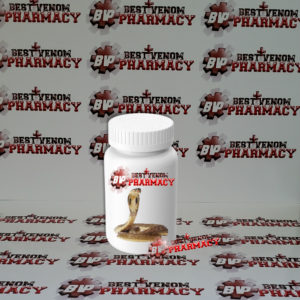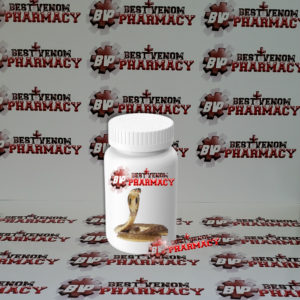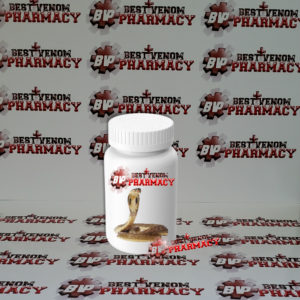Description
BUY HYPNALE HYPNALE VENOM ONLINE
Buy Hypnale hypnale Venom Online, Envenomation by hump-nosed pit viper (Hypnale hypnale, Hh) in Sri Lanka has caused significant morbidity and mortality, attributed to 35% of total venomous snakebites. In Southwestern India (Kerala), H. hypnalewas increasingly identified as a dangerous and common source of envenomation, second to the Russell’s viper but ahead of the cobra bites. Unfortunately, there is still no specific antivenom to date. This study aims to investigate the immunological properties of the venom and to assess the feasibility of specific Hh antivenom production as well as the development of a diagnostic assay. Hh venom elicited satisfactory titers of anti-Hh IgG in rabbits after 3rd immunization. The anti-Hh IgG, isolated with caprylic acid precipitation method, was effective in neutralizing the venom lethality (potency = 48 LD50 per ml IgG) as well as its procoagulant, hemorrhagic and necrotic effects, indicating the possibility to produce the specific antivenom using the common immunization regime. Cross-reactivity studies using indirect ELISA showed that anti-Hh IgG cross-reacted extensively with several Asiatic crotalid venoms, particularly that of Calloselasma rhodostoma (73.6%), presumably due to the presence of venom antigens common to both snakes. Levels of immunological cross-reactivity were vastly reduced with double-sandwich ELISA. Further work demonstrated that the assay was able to distinguish and quantify venoms of H. hypnale, Daboia russeliiand Echis carinatus sinhaleyus (three common local viperid) used to spike human sera at various concentrations. The assay hence may be a useful investigating tool for diagnosing biting species and studying the time course profile of venom concentrations in blood. Buy Hypnale hypnale Venom Online
Hypnale hypnale is a small ovoviviparous pitviper which can be found in Sri Lanka and Peninsular India. According to WHO Guidelines for the Production, Control and Regulation of Snake Antivenom Immunoglobulins, Hypnale hypnale species is of highest medical importance in Sri Lanka and south-western coast of India.
The venom of Hypnale hypnale is used for the production of antivenom immunoglobulins aimed at this region.
Bites from Hypnale hypnale cause moderate to severe coagulopathy and renal damages, such as acute renal failure (ARF).
For Research purposes the venom of Hypnale hypnale is known to contain two phospholipase A2 subtypes (E6-PLA2, W6-PLA2) which dominate the toxin composition (40.1%), followed by snake venom metalloproteases (36.9%), l-amino acid oxidase (11.9%), C-type lectins (5.5%), serine proteases (3.3%) and others (2.3%)
| Adult Length: 0.30 m |
General Shape Buy Hypnale hypnale Venom Online
Small, short, stout cylindrical bodied snake with short, narrow tapering tail. Can grow to a a maximum of about 0.55 metres. Head is broad, triangular shaped, flat, distinct from neck with an acutely pointed, slightly upturned snout, ending in a wedge or hump like prominence slightly turned up. Dorsal scales are weakly keeled. Eyes are medium in size with vertically elliptical pupils. Dorsal scale count 17 ( 19 ) – 17 – 15. |
Habitat
Found in agricultural plantations, particularly amongst leaf litter and damp undergrowth ( rubber, cocoa, coconut, banana, tea, coffee etc. ), forests and grasslands. Widely distributed in Sri Lanka up to about 1500 metres. Up to about 600 metres in India. |
Habits
Nocturnal and terrestrial although semi-arboreal habits have been recorded. It has a peculiar habit of keeping its head raised and pointed at an angle of about 45° when on the ground. Tends to lay at the base of small shrubs and grasses, under logs or in leaf litter during the day. Mild disposition but will strike if cornered or provoked. |
Prey
Feeds mainly on frogs, calotes, geckos, skinks and mice. |
| Venom |
General: Venom Neurotoxins
Probably not present |
General: Venom Myotoxins
Probably not present |
General: Venom Procoagulants
Probably present |
General: Venom Anticoagulants
Possibly present |
General: Venom Haemorrhagins
Probably present |
General: Venom Nephrotoxins
Possibly present |
General: Venom Cardiotoxins
Probably not present |
General: Venom Necrotoxins
Probably not present |
General: Venom Other
Unknown |
|
| Clinical Effects |
General: Dangerousness
Severe envenoming possible, potentially lethal |
| General: Rate of Envenoming: Unknown but likely to be moderate |
| General: Untreated Lethality Rate: Unknown but lethal potential cannot be excluded |
General: Local Effects
Local pain, swelling & bruising |
General: Local Necrosis
Does not occur, based on current clinical evidence |
General: General Systemic Effects
Variable non-specific effects which may include headache, nausea, vomiting, abdominal pain, diarrhoea, dizziness, collapse or convulsions |
General: Neurotoxic Paralysis
Unlikely to occur |
General: Myotoxicity
Not likely to occur |
General: Coagulopathy & Haemorrhages
Uncommon to rare, but may be moderate to severe coagulopathy |
General: Renal Damage
Recognised complication, usually secondary to coagulopathy |
General: Cardiotoxicity
Unlikely to occur |
General: Other
Shock secondary to fluid shifts due to local tissue injury is possible in severe cases |
|
| First Aid |
| Description: First aid for bites by Viperid snakes likely to cause significant local injury at the bite site (see listing in Comments section). |
Details Buy Hypnale hypnale Venom Online
1. After ensuring the patient and onlookers have moved out of range of further strikes by the snake, the bitten person should be reassured and persuaded to lie down and remain still. Many will be terrified, fearing sudden death and, in this mood, they may behave irrationally or even hysterically. The basis for reassurance is the fact that many venomous bites do not result in envenoming, the relatively slow progression to severe envenoming (hours following elapid bites, days following viper bites) and the effectiveness of modern medical treatment.
2. The bite wound should not be tampered with in any way. Wiping it once with a damp cloth to remove surface venom is unlikely to do much harm (or good) but the wound must not be massaged.
3. All rings or other jewellery on the bitten limb, especially on fingers, should be removed, as they may act as tourniquets if oedema develops.
4. The bitten limb should be immobilised as effectively as possible using an extemporised splint or sling; if available, crepe bandaging of the splinted limb is an effective form of immobilisation.
5. If there is any impairment of vital functions, such as problems with respiration, airway, circulation, heart function, these must be supported as a priority. In particular, for bites causing flaccid paralysis, including respiratory paralysis, both airway and respiration may be impaired, requiring urgent and prolonged treatment, which may include the mouth to mask (mouth to mouth) technique of expired air transfer. Seek urgent medical attention.
6. Do not use Tourniquets, cut, suck or scarify the wound or apply chemicals or electric shock.
7. Avoid peroral intake, absolutely no alcohol. No sedatives outside hospital. If there will be considerable delay before reaching medical aid, measured in several hours to days, then give clear fluids by mouth to prevent dehydration.
8. If the offending snake has been killed it should be brought with the patient for identification (only relevant in areas where there are more than one naturally occurring venomous snake species), but be careful to avoid touching the head, as even a dead snake can envenom. No attempt should be made to pursue the snake into the undergrowth as this will risk further bites.
9. The snakebite victim should be transported as quickly and as passively as possible to the nearest place where they can be seen by a medically-trained person (health station, dispensary, clinic or hospital). The bitten limb must not be exercised as muscular contraction will promote systemic absorption of venom. If no motor vehicle or boat is available, the patient can be carried on a stretcher or hurdle, on the pillion or crossbar of a bicycle or on someone’s back.
10. Most traditional, and many of the more recently fashionable, first aid measures are useless and potentially dangerous. These include local cauterization, incision, excision, amputation, suction by mouth, vacuum pump or syringe, combined incision and suction (“venom-ex” apparatus), injection or instillation of compounds such as potassium permanganate, phenol (carbolic soap) and trypsin, application of electric shocks or ice (cryotherapy), use of traditional herbal, folk and other remedies including the ingestion of emetic plant products and parts of the snake, multiple incisions, tattooing and so on. |
|
| Treatment |
Treatment Summary
Bites by hump nosed vipers can cause both local & systemic effects, potentially, though rarely lethal. Require urgent assessment, supportive & symptomatic treatment. No specific antivenom is available, but coverage is claimed for some regional polyvalent products. |
Key Diagnostic Features
Local pain, swelling, + coagulopathy, bleeding, renal failure, shock |
General Approach to Management
All cases should be treated as urgent & potentially lethal. Rapid assessment & commencement of treatment including appropriate antivenom (if indicated & available) is mandatory. Admit all cases. |
Antivenom Therapy
Antivenom is the key treatment for systemic envenoming. Multiple doses may be required. |
Buy Hypnale hypnale Venom Online, Buy Hypnale hypnale Venom Online






